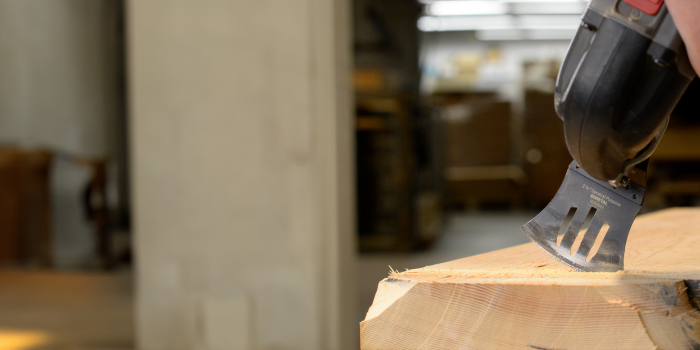Hole saw RPMs so you cut the perfect hole
2018/11/07
Using the right speed, or RPM, will extend the life of your hole saw and give the perfect cut
Excessive speed builds heat and heat destroys cutting tools and when we cut too fast we lose control and accuracy of our cutting operation. That’s why the information is critical to extending the life of your power tools and accessories and cutting the perfect hole—every time.
Bi-metal hole saw cutting fiber cement (HardiePlank) too quickly and burning
The trick to cutting perfect holes in any substrate is getting the RPMs right
Modern hole saws offer various cutting profiles that allow us to cut a wide variety of materials. Bimetal hole saws will allow us to cut all manner of wood and metal products; diamond hole saws are suited to tile and masonry; and carbide tipped are best for high speed wood and fiber cement. However, each substrate hardness and density varies and needs to be cut at the correct speed to provide a precision cut and extended tool life.
For example, as the hole saw diameter increases, the speed, or RPM, should decrease; and harder, denser materials need to be cut at slower speeds. By following these guidelines you will reduce heat build up and hole saw burn out.
What the hole saw RPMs mean or how can I gauge the speed of my drill?
Although portable drills do not come with a speed gauge, most provide variable speeds and many even offer dual speed transmissions for a wider range of speed control. For example, if your drill is rated at 0 to 3,000 RPM and the suggested cutting speed is 1,500 RPM then simply run your drill at half speed. If you are cutting through very hard material such as steel or ceramic tile and the suggested speed is 300 RPM then simply drill very slowly. When cutting hard materials slow speeds will give you more control as well. There is nothing worse than having a diamond hole saw slide across a granite tile and destroy the surface just because we were impatient and cutting too fast.
NOTE: DIAMOND HOLE SAWS
Note that when using diamond hole saws not only is a slow speed important but it is critical that you use water as a cooling lubricant while cutting. This not only keeps the cutting edge cool but also helps remove dust and debris from the cut. See more tips for using hole saw to cut perfect hole.
Diamond hole saw cutting porcelain tile
Recommended bimetal hole saw RPMs for cutting wood, aluminum, mild steel, and stainless steel
|
BIMETAL HOLE SAWS |
RECOMMENDED HOLE SAW SPEED RPM |
||||
|---|---|---|---|---|---|
|
SIZE |
WOOD |
ALUMINUM |
BRASS |
MILD STEEL |
STAINLESS STEEL |
|
Bimetal 3/4" |
3000 |
690 |
600 |
460 |
230 |
|
Bimetal 7/8" |
3000 |
585 |
520 |
390 |
195 |
|
Bimetal 1" |
2700 |
525 |
470 |
350 |
175 |
|
Bimetal 1 1/8" |
2700 |
450 |
400 |
300 |
150 |
|
Bimetal 1 3/16" |
2400 |
425 |
380 |
285 |
145 |
|
Bimetal 1 1/4" |
2400 |
410 |
360 |
275 |
140 |
|
Bimetal 1 3/8" |
2400 |
375 |
330 |
250 |
125 |
|
Bimetal 1 1/2" |
2400 |
345 |
300 |
230 |
115 |
|
Bimetal 1 5/8" |
2100 |
315 |
280 |
210 |
105 |
|
Bimetal 1 3/4" |
2100 |
295 |
260 |
195 |
95 |
|
Bimetal 1 7/8" |
2100 |
270 |
240 |
180 |
90 |
|
Bimetal 2" |
2000 |
255 |
230 |
170 |
85 |
|
Bimetal 2 1/8" |
2000 |
240 |
210 |
160 |
80 |
|
Bimetal 2 1/4" |
2000 |
225 |
200 |
150 |
75 |
|
Bimetal 2 3/8" |
2000 |
220 |
190 |
140 |
70 |
|
Bimetal 2 1/2" |
1800 |
205 |
180 |
135 |
65 |
|
Bimetal 2 9/16" |
1800 |
200 |
175 |
130 |
65 |
|
Bimetal 2 5/8" |
1800 |
195 |
170 |
130 |
65 |
|
Bimetal 2 3/4" |
1800 |
185 |
160 |
125 |
60 |
|
Bimetal 2 7/8" |
1800 |
200 |
175 |
130 |
65 |
|
Bimetal 3" |
1800 |
170 |
150 |
115 |
55 |
|
Bimetal 3 1/8" |
1500 |
165 |
140 |
110 |
55 |
|
Bimetal 3 1/4" |
1500 |
155 |
140 |
105 |
50 |
|
Bimetal 3 3/8" |
1500 |
150 |
130 |
100 |
50 |
|
Bimetal 3 1/2" |
1200 |
145 |
130 |
95 |
45 |
|
Bimetal 3 5/8" |
1200 |
140 |
120 |
90 |
45 |
|
Bimetal 3 3/4" |
1200 |
135 |
120 |
90 |
45 |
|
Bimetal 3 7/8" |
1200 |
135 |
120 |
90 |
45 |
|
Bimetal 4" |
1000 |
130 |
110 |
85 |
40 |
|
Bimetal 4 1/8" |
1000 |
120 |
110 |
80 |
40 |
|
Bimetal 4 1/4" |
900 |
120 |
110 |
80 |
40 |
|
Bimetal 4 1/2" |
900 |
105 |
100 |
75 |
35 |
|
Bimetal 4 3/4" |
900 |
95 |
92 |
75 |
35 |
|
Bimetal 5" |
800 |
90 |
90 |
65 |
30 |
|
Bimetal 5 1/4" |
800 |
85 |
85 |
60 |
25 |
|
Bimetal 5 1/2" |
800 |
85 |
85 |
60 |
25 |
|
Bimetal 6 “ |
700 |
75 |
75 |
55 |
25 |
|
Bimetal 6 1/4" |
700 |
75 |
75 |
55 |
25 |
|
Bimetal 6 5/8" |
700 |
70 |
70 |
50 |
25 |
|
Bimetal 7 7/8" |
700 |
65 |
65 |
40 |
20 |
NOTE:
Cutting ceramic, marble, glass, granite, slate, terrazzo, and fiber cement is not recommended with a bimetal hole saw.
Recommended carbide tipped hole saw RPMs for wood and fiber cement
|
CARBIDE TIPPED HOLE SAWS |
RECOMMENDED HOLE SAW SPEED RPM |
|
|---|---|---|
|
SIZE |
WOOD |
FIBER CEMENT |
|
Carbide Tipped 3/4" |
3000 |
3000 |
|
Carbide Tipped 7/8" |
2700 |
2700 |
|
Carbide Tipped 1" |
2700 |
2700 |
|
Carbide Tipped 1 1/8" |
2700 |
2700 |
|
Carbide Tipped 1 3/8" |
2400 |
2400 |
|
Carbide Tipped 1 1/2" |
2400 |
2400 |
|
Carbide Tipped 1 3/4" |
2100 |
2100 |
|
Carbide Tipped 2", 2 ⅛”, 2 ¼” |
2000 |
2000 |
|
Carbide Tipped 2 1/2", 2 9/16”, 2 ¾”, 3” |
1800 |
1800 |
|
Carbide Tipped 3 3/8", 3 ½” |
1500 |
1500 |
|
Carbide Tipped 3 5/8" |
1200 |
1200 |
|
Carbide Tipped 4" |
900 |
900 |
|
Carbide Tipped 4 1/8" |
900 |
900 |
|
Carbide Tipped 4 1/4" |
900 |
900 |
|
Carbide Tipped 4 5/8" |
900 |
900 |
|
Carbide Tipped 4 3/4" |
900 |
900 |
|
Carbide Tipped 5 1/2" |
800 |
800 |
|
Carbide Tipped 6 1/4" |
700 |
700 |
NOTE:
Cutting aluminum, brass, mild steel, stainless steel, ceramic, marble, glass, granite, slate, and terrazzo is not recommended with a carbide tipped hole saw.
Recommended diamond hole saw RPM
|
DIAMOND HOLE SAWS |
RECOMMENDED HOLE SAW SPEED RPM |
||
|---|---|---|---|
|
SIZE |
CERAMIC + MARBLE |
GLASS |
GRANITE + SLATE + TERRAZZO |
|
Diamond 3/16" |
400* |
100* |
400* |
|
Diamond 1/4" |
400* |
100* |
400* |
|
Diamond 9/32" |
400* |
100* |
400* |
|
Diamond 5/16" |
400* |
100* |
400* |
|
Diamond 3/8" |
400* |
100* |
400* |
|
Diamond 1/2" |
400* |
100* |
400* |
|
Diamond 3/4" |
400* |
100* |
400* |
|
Diamond 1" |
400* |
100* |
400* |
|
Diamond 1 1/4" |
250* |
100* |
250* |
|
Diamond 1 3/8" |
250* |
100* |
250* |
|
Diamond 1 1/2" |
250* |
100* |
250* |
|
Diamond 2" |
150* |
100* |
150* |
|
Diamond 2 1/2" |
150* |
100* |
150* |
|
Diamond 3 3/8" |
100* |
100* |
100* |
|
Diamond 3 5/8" |
100* |
100* |
100* |
|
Diamond 4 3/8" |
100* |
100* |
100* |
*Indicates that water is required for cutting
NOTE:
Cutting wood, aluminum, brass, mild steel, and stainless steel is not recommended with a diamond hole saw. Diamond holes saws can be used to cut fiber cement, but carbide tipped hole saws are preferred.
Exchangeable to save you money and save the planet
Like all EAB Exchange-A-Blade green exchange products, our bimetal, carbide-tipped, and diamond hole saws are fully exchangeable—you buy it, you use it, and when you bring it back to the store where you bought it, you’ll get a credit towards the purchase of your next EAB hole saw. A limited number of these hole saw products are also available in our non-exchangeable brand, Stay Sharp.
About Exchange-A-Blade hole saws
Exchange-A-Blade hole saws are market leaders in quality and value. They can be used to cut holes in wood, ferrous and non-ferrous metal, ceramics, marble, glass, slate, granite, and fiber cement products. They are available in a wide variety of sizes and come in a Professional and Industrial quality.





.jpg)
